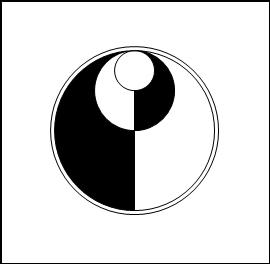




|
Home |
|
Classes |
|
Syllabus / Styles |
|
Biography |
|
Poetry |
|
Photos |
|
Articles |
|
Labyrinths |
|
Storytelling |
|
Artwork |
|
Respects Due |
|
Contact |
|
Links |


|
...with a spirit of self-exploration |

|
Pennine Tai Chi |



|
Yin-Yang |
Tai Chi Tu – Diagram of the Supreme UltimateThe Tai Chi or yin-yang symbol must surely be one of the most recognised symbols in the world. Just 30 years ago, relatively few people in the west would have been familiar with this ancient Chinese diagram, yet today, most people have at least a basic grasp of its meaning. Most books that have any mention of Chinese philosophy, martial arts or feng shui, will explain and list qualities and characteristics of yin and yang. Rather than go over this well covered ground, I would like to look at the development of the yin-yang symbol in it’s various guises and give a few pointers on how these can be constructed. ‘Real understanding requires participation’The above maxim holds true whether we are talking about Tai Chi or anything else in life. It is equally true in the art of sacred geometry, the art of the mandala and in one’s ability to recognise the deeper significance of signs and symbols. Although we will all have some degree of familiarity with the Tai Chi symbol, perhaps not so many people will have drawn a geometrically accurate depiction of it. All of the diagrams in this article can be constructed using the three ancient and classic tools of the geometer; these are the compass, the straightedge and the pencil. Medieval geometers considered the compass to be analogous to the ‘Eye of God’ due to its ability to create from one seed point (of no dimension), the all encompassing and transcendental (w)hole that we call the circle. The straightedge will most likely be a ruler and the pencil of course includes any method of making a mark. Incidentally, the word geometry comes from the Greek root of ‘ge’ (earth) and ‘metron’ (to measure) and so making it ‘the measuring of the earth’.
The ‘Double Fish’ Yin-Yang |
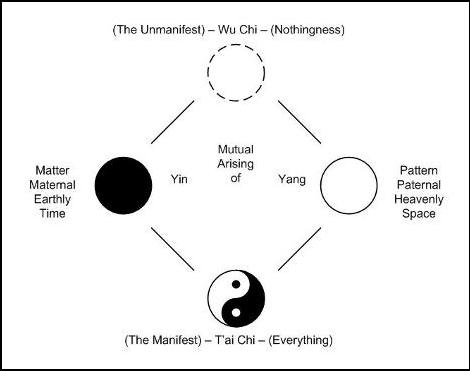
|
Diagram A—Development of the Tai Chi Symbol |
|
This symbol can be traced to around 1000 AD, during the Sung Dynasty, when a Confucian cosmological philosopher called Chou Tun-yi (Zhou Dunying) observed the cyclical relationship of all things. He saw this in the daily cycles of day and night, the phases of the moon, the changing of the seasons, in fact in every aspect of life. From his insights and meditations he designed the double fish configuration to represent these universal characteristics. The outer circle represents the universe (the word ‘universe’ comes from the Latin for ‘one turn’). Within this are contained the light and dark whose interaction show the transmutation of contrasting yet cooperating energies. The white dot within the dark and the black dot within the light show that even at the heart of one there is the seed of the other – all things contain within themselves the germ of their opposites. This does not imply dualism in the ordinary sense because there is always the underlying unity of Tao – the all-embracing circle that gives rise to these mutually interdependent forces. And so, yin and yang are in actuality a harmonious unity, contrary yet complementary, like two ‘Great Extremes’ that bound the immensity of space. The root meaning of the word ‘yin’ is the shaded side of the hill or valley. In contrast the word ‘yang’ comes from the sunny or south side. How to Draw a ‘Double Fish’ Yin-Yang (Clockwise) |
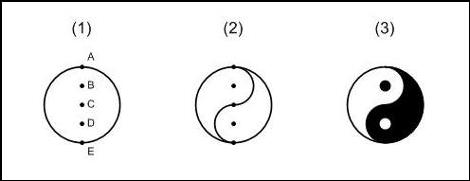
|
Diagram B (1, 2 & 3) |
|
1. Draw a circle of any radius. Across its diameter, mark points A, B, C, D & E – where C is the centre, A & E are on the circumference, and B & D are mid points between the centre and circumference. 2. With the compass point on B, draw the right hand half of a circle (between C & A). With the compass point on D, draw the left hand half of a circle (between C & E). 3. With the compass point on B & D, draw small circles – the yin within yang and the yang within yin – (the fish’s eyes).
The Spiral Yin-Yang |
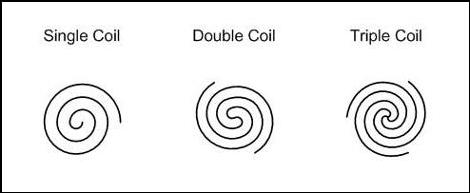
|
Diagram C (1, 2 & 3) - Spiral Patterns |
|
The origins of the spiral yin-yang are obscure but it is thought to predate the double fish configuration. Its principles are developed from spiral patterns that are amongst the earliest known marks made by humanity and found in rock carvings at many ancient sites.
How to Draw a ‘Spiral’ Yin-Yang (Clockwise) |
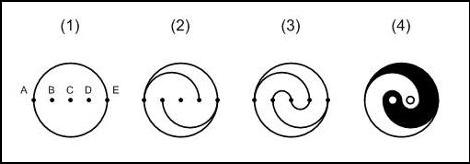
|
Diagram D (1, 2, 3 & 4) |
|
1. Draw a circle of any radius. Across its diameter mark points A, B, C, D & E as in the double fish configuration. 2. Between A & D, draw the top half of a circle. Between B & E, draw the bottom half of a circle. 3. Between B & C, draw the top half of a circle. Between C & D, draw the bottom half of a circle. 4. With compass point on the same places as used to draw all the previous semi-circles, now draw two small circles – (the embryos).
Lai’s Yin-YangYet another variation of the yin-yang symbol is attributed to a metaphysician from the Sung Dynasty (AD 960 – 1279) called Lai. |
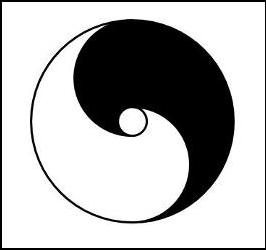
|
Diagram E—Lai’s Yin-Yang |
|
The central circle represents Wu Chi (nothingness / void) from which Tai Chi emerges and then returns. This version of the diagram also emphasises the spiralling nature of energy.
How to Draw Lai’s Yin-Yang (Anti-clockwise)1. Draw a small circle and a large circle both with the same centre. 2. Draw the left hand half of a circle between the lowest point of the small circle and the highest point of the large circle. 3. Draw the right hand half of a circle between the highest point of the small circle and the lowest point of the large circle.
Concentric Yin-YangAnother fairly rare version of the yin-yang is one that uses concentric circles divided in half and alternating black and white to each side. |
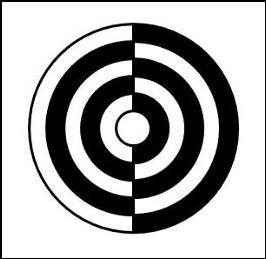
|
Diagram F—Concentric Yin-Yang |
|
Some versions also have the centre circle split between black and white, whilst other versions keep this blank and so representing the pure seed from which all of creation is born. Where five concentric circles surround the inner circle – this can be seen as the manifestation of the five elements (Earth, Metal, Water, Wood and Fire), each with their yin and yang aspects.
In-Yo SymbolIn Japan, the dual qualities of ‘yin’ and ‘yang’ are known as ‘in’ and ‘yo’ respectively. ‘Inyodo’, meaning ‘The Way of Yin and Yang’ is Japanese feng shui. The in-yo symbol has a large circle that represents the universe. Within this and connecting with it at just one point, there is a smaller circle. The larger area is usually white or sliver, the smaller circle is red or occasionally black. When red, it reflects the image of the sun disc on the Japanese flag and the silver / white crescent is seen as representative of the moon. This symbol is used by some Japanese karate organisations. A variation of this symbol is where the white circle contains a black circle that contains a white circle that contains a black circle, implying that this goes on and on to infinity. |
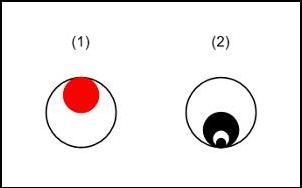
|
Diagram G—(1 & 2) |
Tao Te ChingChapter 42 (Part)The Tao begot one. One begot two. Two begot three. And three begot the ten thousand things.
The ten thousand things carry yin and embrace yang. They achieve harmony by combining these forces.
This can be interpreted as the Tao giving birth to the Universe (the One) which gives rise to Yin and Yang (the Two), whose interaction creates Energy / Chi (the Three) from which comes Everything (the Ten Thousand Things). |
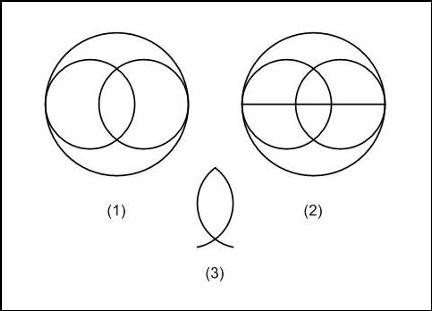
|
Diagram H—(1, 2 & 3) |
|
This same idea can be seen to be expressed geometrically in Western sacred art. Where two circles intersect, their shared area forms a ‘vesica piscis’ or birth portal. In diagram H (1), the circle that encompasses the whole, represents ‘the one’. The smaller intersecting circles represent male& female / yin & yang – ‘the two’. The resulting interplay of these gives birth to ‘the three’ which when seen on its own as in diagram H (3) is seen as a fish shape and is often associated with Christ. This shape is much used in the architecture of cathedrals and in stained glass windows. In diagram H (2); a horizontal line is added that also divides the vesica piscis into its upward pointing yang aspect and its downward pointing yin aspect, signifying how the vulva gives birth to both male and female.
I ChingPerhaps the simplest representations for yin - ‘the great obscurity’ and yang - ‘the great brightness’, are those used in the I Ching. A broken and a solid line signify yin and yang respectively and these are combined in groups of three where the upper line represents Heaven, the lower line Earth and the middle line Humanity. The two types of line combined into groups of three make the eight possible trigrams. |

|
Diagram I—Trigrams |
|
The flag of South Korea has a white background with a yin-yang symbol in blue and red, where blue is yin and red is yang. In Korea, ‘yin’ and ‘yang’ are referred to as ‘um’ and ‘yang’ and the symbol is surrounded by the trigrams of the four primary directions. These trigrams are: upper left – heaven; lower right – earth; lower left – fire; upper right – water. |
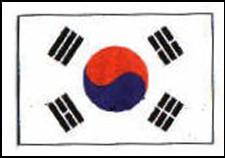
|
Flag of South Korea |
SummarySo why has the Yin-Yang symbol (in particular the ‘double fish diagram’ attributed to Chou Tun-yi) been so enduring – speaking to so many people? It has survived turmoil and revolution in China and has crossed cultural boundaries to become truly international. Surely the reason must be because in such a simple and concise form, it expresses such great and all embracing profundity. |

|
Diagram J—4 Phases of Yin-Yang |
|
Bibliography Taoism – The Way of the Mystic by J. C. Cooper The Simple Way of Lao Tsze from Shrine of Wisdom Books Tao Te Ching Translation by Gia-Fu Feng The History & Philosophy of Kung Fu by E. C. Medeiros A Beginner’s Guide to Constructing the Universe by Michael Schneider |

|
Day and Night Woodcut by M. C. Escher (Rectangular fields transform into black birds that flg towards the light of day and white birds that fly into the black of night) |
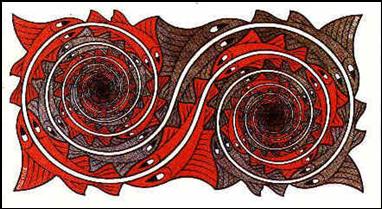
|
Whirlpools (Double Fish Spiral) by M. C. Escher |
FootnoteOn a recent visit to China, I came across this variation of the yin-yang symbol. I would be interested to hear if anyone knows anything of the background and origins of this variation. |
